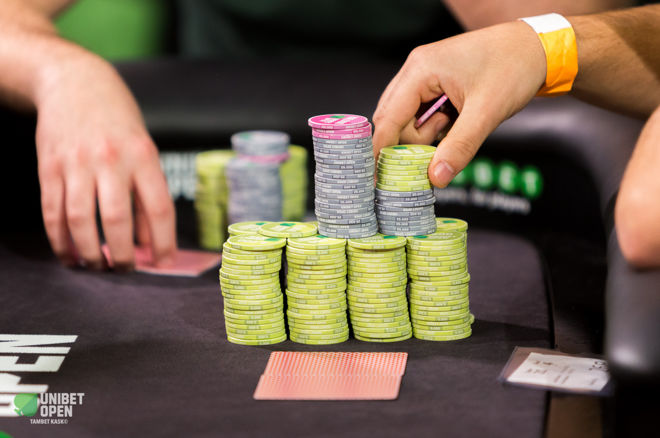With this no-limit hold’em tip we’re focusing largely on preflop strategy, in particular the very useful move to “steal” the blinds, as well as to “resteal” which is a move that can be tried in response to stealing.
What is Stealing?
Stealing refers to an opening raise made before the flop, usually from a player in late position and most often with a weak starting hand. Those latter details are what technically make the raise a “steal”, given that the player isn’t really raising based on hand strength and is mostly hoping not to be called and win the small and big blinds (and antes, if in play) without having to see a flop.
In other words, the move is essentially a bluff.
However, any late position opening raise can be described as a “steal” attempt regardless of the player’s actual cards. A player might open-raise with a good hand and watch everyone fold in response, and that will still be looked upon as “stealing.” It’s a “position play” that often works for a couple of reasons.
One is the fact that when open-raising from late position, there are relatively few players left in the hand who might call or reraise — indeed, a steal attempt from the button only needs to get through the small and big blinds to be successful. The other reason late-position preflop steals often work is that many players in the blinds aren’t inclined to call raises and be forced to play hands from out of position after the flop.
Technically speaking, a player can be trying to steal from any position, although for the most part it’s a play made by those in late positions — i.e., the hijack seat, the cutoff, and the button. When folded to in these positions, you should always at least consider whether or not you can raise to steal the blinds before tossing away even the weakest starting hands.
Reasons to Try Stealing the Blinds
In no-limit hold’em, if you restrict yourself only to raising before the flop with premium or so-called “top 10” starting hands, you won’t be raising very much at all. That alone should be one motivation to try blind steals every now and then — it gets you involved in hands more often as the aggressor and (often) in position, both of which are generally more profitable ways to play.
Even if you happen to get called by a player in either the small or big blind when trying to steal, you’re still in a good position to win a pot without a showdown.
Say you open with a raise from the button with a random “trash” hand like 
 and get called by the big blind. The flop comes
and get called by the big blind. The flop comes 

 and your opponent checks, and you make a continuation bet. Without a king, queen, or seven — or perhaps a pocket pair or a straight draw — your opponent will often be folding, earning you an even bigger pot than just the blinds you’d originally been hoping to steal.
and your opponent checks, and you make a continuation bet. Without a king, queen, or seven — or perhaps a pocket pair or a straight draw — your opponent will often be folding, earning you an even bigger pot than just the blinds you’d originally been hoping to steal.
Attempting blind steals every so often also will help affect your image going forward, earning you action during those other hands when you actually have strong starters and want your preflop raises to be called. If you’re inclined to play a tight style (maybe even too tight), blind stealing is a relatively easy way to start incorporating occasional, low-risk bluffs into your game. Sometimes your steal attempts will fail, but that, too, can be a positive as it shows the table you don’t restrict yourself to betting only when you “have it”, thereby making it more likely you’ll get callers on those occasions when you are betting or raising with strong hands.
Players who understand the effectiveness of blind stealing instinctively know that someone open-raising from late position can have a wide variety of possible starting hands — that is, a relatively wide “range”. Thus not only are you setting yourself up to play a hand in position and as the aggressor, but with a hard-to-pinpoint range, too, making it even less attractive for opponents to call you from the blinds to see flops.
Blind Stealing: Cash Games vs. Tournaments
So far we’ve been characterizing the blind steal as a relatively low-risk way to earn small pots uncontested, or perhaps slightly bigger pots without having to go to showdowns in those cases when your preflop raise gets called, but you then take down hands after continuation betting and getting folds.
The math of the situation shows how a blind steal doesn’t have to work every time to be profitable. Say the blinds are $1/$2 and you’ve raised to $5 as a steal attempt — that is, you’re betting $5 in an attempt to win $3. If the blind steal works two out of three times, you win $6 and lose $5, coming out a buck ahead.
That said, blind stealing in cash games usually isn’t as smart an idea as in tournaments, especially in deeper-stacked cash games where the amount of the blinds is small compared to the total stacks. In such cases, taking even small risks to win small pots isn’t so important to do, and can actually get you into trouble losing bigger pots as you find yourself involved in hands postflop with weak holdings.
Meanwhile in tournaments blind stealing is an important, even necessary play to incorporate into your game. Unlike in cash games, in tournaments the blinds increase as the tournament proceeds, making them all the more inviting to try to steal. Also, the addition of antes can make it even more profitable to steal while also reducing the need to be successful with your steals as frequently.
Imagine you’re in a full ring (nine-handed), no-limit hold’em tournament and the blinds are 1,000/2,000 with a 300 ante. That means there is already 5,700 in the middle before the cards are even dealt. Say you open with a min-raise to 4,000 from the button — that steal attempt only needs to work a little over half the time to be profitable for you.
Early in tournaments the blinds are usually small relative to stack sizes, which tends to make blind stealing less vital to try early on. If you have a starting stack of 100 big blinds, a successful steal in the first level only nets you 1.5 big blinds or a tiny 1.5 percent increase to your stack. (However, that doesn’t mean you should never try to steal early in a tournament, as it can still work to affect your image in a positive way later on.)
Restealing: From Late Position or the Blinds
Okay, so we’ve established that stealing can be profitable and there are several reasons in favor of trying to steal the blinds on occasion. Other smart players know this, too, and thus correctly view with suspicion some of those late-position opening raises.
Enter restealing.
The “resteal” is yet another bluff, in this case a reraise over a preflop opening raise that is similarly intended to win the pot right then and there. The rewards are even greater when restealing, earning the blinds (and antes, if there are any) and the amount of the original raise if successful.
If a player has raised from the hijack, another might try to resteal from the cutoff or button. Similarly an opening raise from the cutoff might be met with a reraise from the button. These resteals from a later position can be especially effective, benefited by that same power of position described above.
Restealing can also be attempted from the blinds (from out of position), and in fact that’s where you’ll see restealing happening most frequently. Players who don’t fold their blinds to raises are described as “defending” their blinds, and can do so either by calling or by reraising. Sometimes the reraise is a “resteal” attempt — that is, when the player in the blinds is bluffing with a less-than-strong hand in order to win the pot without going any further.
When going for a straight steal, you do want to be mindful of the remaining players left to act and what their tendencies are, understanding that against tighter players, steals are going to work more often.
When restealing it’s even more important to have a good read on your opponent. Specifically, you want to have a strong, well-founded impression that your opponent is capable of stealing, thus making it more likely that late-position opening raise is being done with a weak hand. Your reraise, then, becomes difficult for that player to call.
Imagine that situation up above and a player raising from the button with 
 . When you reraise from the blinds, that player isn’t very likely going to call with such a poor hand. Generally speaking you want your reraise to be big enough to make loose calls with poor or even somewhat speculative hands incorrect.
. When you reraise from the blinds, that player isn’t very likely going to call with such a poor hand. Generally speaking you want your reraise to be big enough to make loose calls with poor or even somewhat speculative hands incorrect.
Your own image is important here, too. If you’ve shown yourself to be a reasonably disciplined player who doesn’t get out of line that often, restealing is more likely going to work for you. But if your image is that of a loose-aggressive player who bluffs a lot, the resteal might not be smart to try.
Like with stealing, you can be called when restealing then still win a pot with a continuation bet after your opponent misses the flop, thus earning you even more chips (and without having to have made a hand).
Whether playing poker online or live, learn how to incorporate both stealing and restealing into your preflop strategy, opening up your game and earning you chips without having to depend on getting cards and showing down winners to do so.
Tagged with: advanced strategy • Cash Games • poker strategy • tournament strategy




